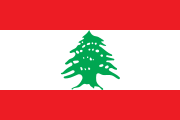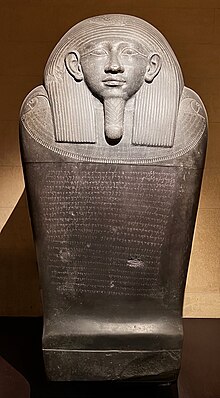
Back بوابة:لبنان Arabic بوابة:لبنان ARZ Portail:Liban French Portale:Libano Italian Portal:Lubnan Malay Portal:Líbano Portuguese Портал:Ливан Russian باب:لبنان Urdu Cổng thông tin:Liban Vietnamese
The Lebanon PortalA view of Byblos, Lebanon
 Lebanon (/ˈlɛbənɒn, -nən/ LEB-ə-non, -nən; Arabic: لُبْنَان, romanized: Lubnān, local pronunciation: [lɪbˈneːn]), officially the Republic of Lebanon, is a country in the Levant region of West Asia. It is bordered by Syria to the north and east, by Israel to the south, and by the Mediterranean Sea to the west; Cyprus lies a short distance away from the country's coastline. Lebanon is located at the crossroads of the Mediterranean Basin and the Arabian hinterlands. Lebanon has a population of more than five million people and covers an area of 10,452 square kilometres (4,036 sq mi). Beirut is the country's capital and largest city. The earliest evidence of human civilization in Lebanon dates back to 5000 BCE. From 3200 to 539 BC, what was to become Lebanon was part of Phoenicia, a maritime empire that stretched the Mediterranean Basin. In 64 BC, the region of Lebanon became part of the Roman Empire, which soon became a major center for Christianity under the aegis of the Byzantine Empire. After the 7th century, the region came under the rule of different caliphates, including the Rashidun, Umayyad and Abbasid caliphates. The 11th century saw the beginning of the Crusades and the establishment of Crusader states, which later fell to the Ayyubids and the Mamluks, and eventually to the Ottomans. Under Ottoman ruler Abdulmejid I, the first Lebanese proto-state was established in the form of the Mount Lebanon Mutasarrifate, created in the 19th century as a home for Maronite Christians under the Ottoman Tanzimat period. Lebanon is a developing country, ranked 112th on the Human Development Index. It has been classified as an upper-middle-income state. The Lebanese liquidity crisis, coupled with nationwide corruption and recent disasters such as the 2020 Beirut explosion, have precipitated the collapse of Lebanon's currency and fomented political instability, widespread resource shortages, and high unemployment and poverty. The World Bank has defined Lebanon's economic crisis as one of the world's worst since the 19th century. Despite the country's small size, Lebanese culture is renowned both in the Arab world and globally, powered primarily by the Lebanese diaspora. Lebanon is a founding member of the United Nations and of the Arab League, and is a member of the Non-Aligned Movement, the Organization of Islamic Cooperation, the Organisation internationale de la Francophonie, and the Group of 77, among others. (Full article...) This is a Featured article, one of the best articles Wikipedia has to offer.
Fakhr al-Din Ma'n (Arabic: فَخْر ٱلدِّين مَعْن, romanized: Fakhr al-Dīn Maʿn; c. 1572 – March or April 1635), commonly known as Fakhr al-Din II or Fakhreddine II (Arabic: فخر الدين الثاني, romanized: Fakhr al-Dīn al-Thānī), was the paramount Druze emir of Mount Lebanon from the Ma'n dynasty, an Ottoman governor of Sidon-Beirut and Safed, and the strongman over much of the Levant from the 1620s to 1633. For uniting modern Lebanon's constituent parts and communities, especially the Druze and the Maronites, under a single authority for the first time in history, he is generally regarded as the country's founder. Although he ruled in the name of the Ottomans, he acted with considerable autonomy and developed close ties with European powers in defiance of the Ottoman imperial government. Fakhr al-Din succeeded his father as the emir of the Chouf mountains in 1591. He was appointed over the sanjaks (districts) of Sidon-Beirut in 1593 and Safed in 1602. Despite joining the rebellion of Ali Janbulad in 1606, Fakhr al-Din remained in his post and the Ottomans recognized his takeover of the Keserwan mountains from his rival Yusuf Sayfa. Seven years later, an imperial campaign was launched against him for allying with Tuscany and garrisoning the strategic fortresses of Shaqif Arnun and Subayba. He escaped and became an exile in Tuscany and Sicily. Upon his return in 1618, he resumed control of his former domains and within three years took over northern Mount Lebanon, which was predominantly Maronite. After Fakhr al-Din routed the governor of Damascus at the Battle of Anjar in 1623, he extended his control to the Beqaa Valley, the stronghold of his rivals, the Harfush dynasty. Fakhr al-Din proceeded to capture fortresses across central Syria, gained practical control of Tripoli and its eyalet, and acquired tax farms as far north as Latakia. Although he frequently attained government favor by timely forwarding of tax revenue, bribing officials, and using opportunities of mutual interest to eliminate local rivals, his outsized power and autonomy were considered a rebellion by the imperial government. A near-contemporary historian remarked that "the only thing left for him to do was to claim the Sultanate". He surrendered to the Ottomans during a siege of his Chouf hideout in 1633 and was executed in Constantinople two years later. In 1697 Fakhr al-Din's grandnephew was awarded a tax farm spanning southern Mount Lebanon. It was gradually expanded by the Ma'ns' marital relatives, the Shihabs, in 1711, and was a precursor to the Lebanese Republic. According to the historian Kamal Salibi, Fakhr al-Din "combined military skill and eminent qualities of leadership with a keen business acumen and unusual powers of observation". During a period when the empire was in a long economic crisis, Fakhr al-Din's territories thrived, and Sidon in particular attained political significance for the first time in its modern history. He protected, promoted, and helped modernize commercial agriculture in his domains, inaugurating the lucrative silk trade of Mount Lebanon. By opening his port towns for European commerce, he facilitated the most significant European political and economic penetration of the Levantine coast since the 13th century. Fakhr al-Din's wealth, derived mainly from his tax farms, but also from extortion and counterfeiting, enabled him to invest in the fortifications and infrastructure needed to foster stability, order, and economic growth. His building works included palatial government houses in Sidon, Beirut and his Chouf stronghold of Deir al-Qamar, caravanserais, bathhouses, mills, and bridges, some of which remain extant. Tax farming financed his army of sekban mercenaries, which after 1623 mostly replaced the local peasant levies on which he previously depended. Christians prospered and played key roles under his rule, with his main enduring legacy being the symbiotic relationship he set in motion between Maronites and Druze, which proved foundational for the creation of a Lebanese entity. (Full article...)Did you know (auto-generated) -
TopicsRelated portalsReligions in Lebanon Arab states Other countries This is a Good article, an article that meets a core set of editorial standards.
The sarcophagus of Eshmunazar II is a 6th-century BC sarcophagus unearthed in 1855 in the grounds of an ancient necropolis southeast of the city of Sidon, in modern-day Lebanon, that contained the body of Eshmunazar II (Phoenician: 𐤀𐤔𐤌𐤍𐤏𐤆𐤓 ʾšmnʿzr, r. c. 539 – c. 525 BC), Phoenician King of Sidon. One of only three Ancient Egyptian sarcophagi found outside Egypt, with the other two belonging to Eshmunazar's father King Tabnit and to a woman, possibly Eshmunazar's mother Queen Amoashtart, it was likely carved in Egypt from local amphibolite, and captured as booty by the Sidonians during their participation in Cambyses II's conquest of Egypt in 525 BC. The sarcophagus has two sets of Phoenician inscriptions, one on its lid and a partial copy of it on the sarcophagus trough, around the curvature of the head. The lid inscription was of great significance upon its discovery as it was the first Phoenician language inscription to be discovered in Phoenicia proper and the most detailed Phoenician text ever found anywhere up to that point, and is today the second longest extant Phoenician inscription, after the Karatepe bilingual. The sarcophagus was discovered by Alphonse Durighello, a diplomatic agent in Sidon engaged by Aimé Péretié, the chancellor of the French consulate in Beirut. The sarcophagus was sold to Honoré de Luynes, a wealthy French nobleman and scholar, and was subsequently removed to the Louvre after the resolution of a legal dispute over its ownership. More than a dozen scholars across Europe and the United States rushed to translate the sarcophagus inscriptions after its discovery, many noting the similarities between the Phoenician language and Hebrew. The translation allowed scholars to identify the king buried inside, his lineage, and his construction feats. The inscriptions warn against disturbing Eshmunazar II's place of repose; it also recounts that the "Lord of Kings", the Achaemenid king, granted Eshmunazar II the territories of Dor, Joppa, and Dagon in recognition for his services. (Full article...)General imagesThe following are images from various Lebanon-related articles on Wikipedia.
CategoriesAssociated WikimediaThe following Wikimedia Foundation sister projects provide more on this subject:
SourcesDiscover Wikipedia using portals |
© MMXXIII Rich X Search. We shall prevail. All rights reserved. Rich X Search
























































